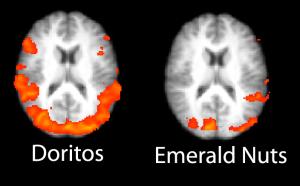I am sure that this experiment was initially conceived by grad students:

FKF Applied Research and the UCLA Ahmanson Lovelace Brain Mapping Center have released their Second Annual Ranking of the most effective Super Bowl ads using fMRI (functional Magnetic Resonance Imaging) brain imaging. Many of the Super Bowl ads stoked regions of the brain associated with anxiety, including the amygdala.
Compared to last year’s ads there was much more anxiety, and far less positive emotion in these highly touted commercials. “This clearly was the year of the amygdala, the brain’s ‘threat detector,” said Dr. Joshua Freedman UCLA Clinical Assistant Professor of Psychiatry and a co-founder of FKF Applied Research. “Much of the anxiety seemed caused by violence, but was also rooted in economic fears. The Nationwide ad had a spike when Kevin Federline was revealed to be working in fast food, and also when the GM robot turned out to be OK but afraid for its job.”
FKF Applied Research and Dr. Marco Iacoboni’s group at the UCLA Ahmanson Lovelace Brain Mapping Center recruited men and women ages 18-34 to watch this year’s Super Bowl ads. The subjects viewed the ads while in UCLA’s high-field fMRI scanner, which monitors the activity in their brains.
FKF and UCLA’s empirical approach measures activity in regions of the brain known to help control whether a consumer will buy or reject a marketer’s sales pitch. The fMRI used by FKF and UCLA displays activity in parts of the brain responsible for elemental responses, including wanting, reward, surprise, fear, disgust, conflict, and attempts to control emotions. The fMRI technology was also recently featured in a study that examined the brain’s activity while playing violent and non-violent video games.
This is actually the second year that UCLA has evaluated ads, and while the application seems kind of spurious in a medical imaging context, as far as neuroscience goes it’s certainly good to have some direct evidence that the best advertisements are the ones that scare you silly. Then again, maybe that’s what it takes to get noticed, After all, as the article noted, “the majority [of ads] elicited very little response.”
I haven’t been able to find the actual study online – it’s worth mentioning that the amygdala is not visible at the slice level shown in the accompanying figure. I assume that they have more relevant images to show that bolster the thesis 🙂
Incidentally, the UCLA Brain Mapping Center actually runs a pretty cool website, BrainMapping.org, aimed more at neuroscience than medical imaging. The